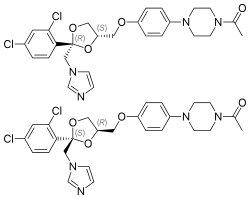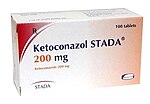
Back كيتوكونازول Arabic کتوکونازول AZB Cetoconasol Welsh Ketoconazol German Κετοκοναζόλη Greek Ketoconazol Spanish کتوکونازول Persian Ketokonatsoli Finnish Kétoconazole French Ketoconazol Galician
 (2R,4S)-(+)-ketoconazole (top) (2S,4R)-(−)-ketoconazole (bottom) | |
 Ball-and-stick model of (2R,4S)-(+)-ketoconazole | |
| Clinical data | |
|---|---|
| Pronunciation | /ˌkiːtoʊˈkoʊnəˌzoʊl, -zɒl/[1][2] |
| Trade names | Nizoral, others |
| Other names | R-41400; KW-1414 |
| AHFS/Drugs.com | Monograph |
| MedlinePlus | a682816 |
| License data |
|
| Pregnancy category |
|
| Routes of administration | By mouth (tablets), topical (cream, shampoo, solution) |
| ATC code | |
| Legal status | |
| Legal status | |
| Pharmacokinetic data | |
| Bioavailability | By mouth: 37–97%[8] |
| Protein binding | 84 to 99% |
| Metabolism | Extensive liver (predominantly oxidation, O-dealkylation) |
| Metabolites | N-deacetyl ketoconazole |
| Elimination half-life | Biphasic |
| Excretion | Bile duct (major) and kidney[9] |
| Identifiers | |
| |
| CAS Number | |
| PubChem CID | |
| IUPHAR/BPS | |
| DrugBank | |
| ChemSpider | |
| UNII | |
| KEGG | |
| ChEBI | |
| ChEMBL | |
| PDB ligand | |
| CompTox Dashboard (EPA) | |
| ECHA InfoCard | 100.059.680 |
| Chemical and physical data | |
| Formula | C26H28Cl2N4O4 |
| Molar mass | 531.43 g·mol−1 |
| 3D model (JSmol) | |
| Chirality | Racemic mixture[9][10] |
| |
| |
| | |

Ketoconazole, sold under the brand name Nizoral, among others, is an antiandrogen, antifungal, and antiglucocorticoid medication used to treat a number of fungal infections.[11] Applied to the skin it is used for fungal skin infections such as tinea, cutaneous candidiasis, pityriasis versicolor, dandruff, and seborrheic dermatitis.[12] Taken by mouth it is a less preferred option and recommended for only severe infections when other agents cannot be used.[11] Other uses include treatment of excessive male-patterned hair growth in women and Cushing's syndrome.[11]
Common side effects when applied to the skin include redness.[12] Common side effects when taken by mouth include nausea, headache, and liver problems.[11] Liver problems may result in death or the need for a liver transplantation.[11][13] Other severe side effects when taken by mouth include QT prolongation, adrenocortical insufficiency, and anaphylaxis.[11][13] It is an imidazole and works by hindering the production of ergosterol required for the fungal cell membrane, thereby slowing growth.[11]
Ketoconazole was patented in 1977 by Belgian pharmaceutical company Janssen, and came into medical use in 1981.[14] It is available as a generic medication and formulations that are applied to the skin are over the counter in the United Kingdom.[12] In 2022, it was the 175th most commonly prescribed medication in the United States, with more than 2 million prescriptions.[15][16] The formulation that is taken by mouth was withdrawn in the European Union and in Australia in 2013,[17][18] and in China in 2015.[19] In addition, its use was restricted in the United States and Canada in 2013.[18]
- ^ "Ketoconazole". Merriam-Webster.com Dictionary. Merriam-Webster.
- ^ "Ketoconazole". Dictionary.com Unabridged (Online). n.d.
- ^ "FDA-sourced list of all drugs with black box warnings (Use Download Full Results and View Query links.)". nctr-crs.fda.gov. FDA. Retrieved 22 October 2023.
- ^ "Ketoconazole HRA 200mg Tablets - Summary of Product Characteristics (SmPC)". (emc). 18 September 2017. Archived from the original on 2 August 2020. Retrieved 1 April 2020.
- ^ "Ketoconazole 2% w/w Shampoo - Summary of Product Characteristics (SmPC)". (emc). 5 October 2015. Archived from the original on 3 August 2020. Retrieved 1 April 2020.
- ^ Cite error: The named reference
Ketoconazole tablet labelwas invoked but never defined (see the help page). - ^ Cite error: The named reference
Ketoconazole HRA EPARwas invoked but never defined (see the help page). - ^ Cite error: The named reference
Millikan2016was invoked but never defined (see the help page). - ^ a b "Assessment report: Ketoconazole HRA" (PDF). European Medicines Agency (EMA). Archived (PDF) from the original on 27 August 2016. Retrieved 26 August 2016.
- ^ Arakaki R, Welles B (February 2010). "Ketoconazole enantiomer for the treatment of diabetes mellitus". Expert Opinion on Investigational Drugs. 19 (2): 185–94. doi:10.1517/13543780903381411. PMID 20047506. S2CID 26531459.
- ^ a b c d e f g "Ketoconazole Monograph for Professionals". Drugs.com. American Society of Health-System Pharmacists. Archived from the original on 28 December 2010. Retrieved 23 March 2019.
- ^ a b c British national formulary : BNF 76 (76 ed.). Pharmaceutical Press. 2018. p. 1198. ISBN 9780857113382.
- ^ a b "FDA limits usage of Nizoral (ketoconazole) oral tablets due to potentially fatal liver injury and risk of drug interactions and adrenal gland problems". FDA Drug Safety Communication. U.S. Food and Drug Administration. 26 July 2013. Archived from the original on 2 December 2013. Retrieved 23 November 2013.
- ^ Fischer J, Ganellin CR (2006). Analogue-based Drug Discovery. John Wiley & Sons. p. 503. ISBN 9783527607495.
- ^ "The Top 300 of 2022". ClinCalc. Archived from the original on 30 August 2024. Retrieved 30 August 2024.
- ^ "Ketoconazole Drug Usage Statistics, United States, 2013 - 2022". ClinCalc. Retrieved 30 August 2024.
- ^ "Oral ketoconazole (Nizoral) 200 mg tablets". Therapeutic Goods Administration (TGA). 10 October 2013. Archived from the original on 2 July 2015. Retrieved 23 March 2019.
- ^ a b Gupta AK, Lyons DC (2015). "The Rise and Fall of Oral Ketoconazole". Journal of Cutaneous Medicine and Surgery. 19 (4): 352–7. doi:10.1177/1203475415574970. PMID 25775613. S2CID 206695486.
- ^ "国家食品药品监督管理总局关于停止生产销售使用酮康唑口服制剂的公告(2015年第85号)" (in Chinese). China Food and Drug Administration. 25 June 2015. Archived from the original on 2 July 2015. Retrieved 2 July 2015.